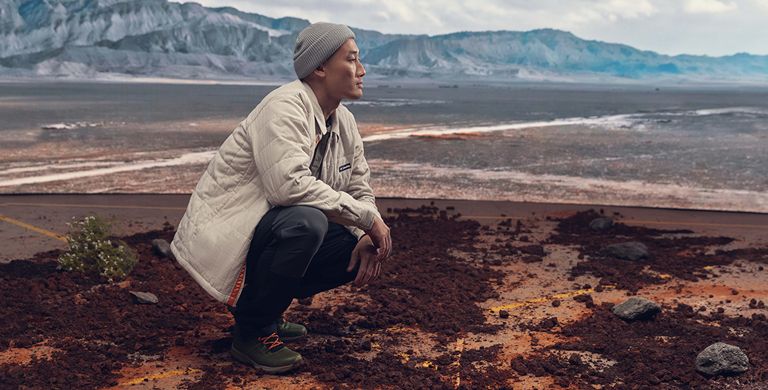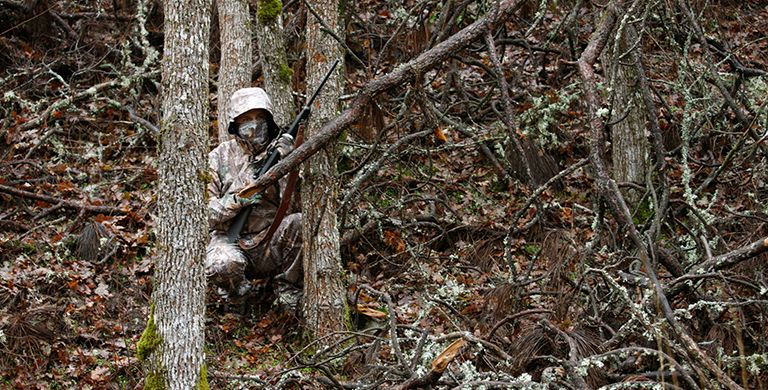OUTDOOR LIFE
The Amazing Benefits of Cold Plunging
From reduced inflammation to improved mood, ice bathing may offer a range of health benefits
BY RACHEL CAVANAUGH
Rachel Pohl lives in Flakstadøya, Norway, where the climate ranges between cold and frigid. Outside her home, frosty blue waves lap against the arctic shoreline and blocks of ice float in the seawater.
It’s the last place you’d expect anyone to strip down to their bathing suit and jump into the ocean. But Pohl is part of a growing number of ice bathing enthusiasts who have discovered the joys of cold plunging as well as some major health benefits.
“I love it so much,” says the Montana-born artist, who owns and operates Rachel Pohl Art. “My favorite way to do it is to swim in lakes or oceans when I go hiking. But sometimes I just stand under the cold shower for two or three minutes.”
Once a semi-pro ice climber and competitive skier, Pohl currently spends a lot of time hiking, backpacking, skiing, and trail running. She says that having a consistent ice bathing routine has been instrumental in supporting her, both as an athlete and well-rounded human being.
“The endorphin boost you get after doing a cold plunge is so intense. I can’t stop laughing. It’s my favorite thing,” she says.
It’s the last place you’d expect anyone to strip down to their bathing suit and jump into the ocean. But Pohl is part of a growing number of ice bathing enthusiasts who have discovered the joys of cold plunging as well as some major health benefits.
“I love it so much,” says the Montana-born artist, who owns and operates Rachel Pohl Art. “My favorite way to do it is to swim in lakes or oceans when I go hiking. But sometimes I just stand under the cold shower for two or three minutes.”
Once a semi-pro ice climber and competitive skier, Pohl currently spends a lot of time hiking, backpacking, skiing, and trail running. She says that having a consistent ice bathing routine has been instrumental in supporting her, both as an athlete and well-rounded human being.
“The endorphin boost you get after doing a cold plunge is so intense. I can’t stop laughing. It’s my favorite thing,” she says.
“It's so noticeable how much better my legs feel and how much I expedite the recovery process.”
Yassine Diboun, Pro Trail Runner
You don’t need to live in exotic arctic locations to start cold plunging though—professional trail runner Yassine Diboun does it in his own backyard. It’s a habit he’s been practicing for 15 years.
“The benefits I get are huge,” he says. “It's so noticeable how much better my legs feel and how much I expedite the recovery process.”
The Columbia Sportswear ultra-marathoner, who runs the coaching business Wy'east Wolfpack, points to things like reduced inflammation, improved circulation, and quicker muscle recovery as just a handful of the benefits he has gleaned over the years.
Below, the two cold plunging experts discuss the key benefits they’ve received from maintaining a regular ice bathing practice, along with a few tips to get started.
“The benefits I get are huge,” he says. “It's so noticeable how much better my legs feel and how much I expedite the recovery process.”
The Columbia Sportswear ultra-marathoner, who runs the coaching business Wy'east Wolfpack, points to things like reduced inflammation, improved circulation, and quicker muscle recovery as just a handful of the benefits he has gleaned over the years.
Below, the two cold plunging experts discuss the key benefits they’ve received from maintaining a regular ice bathing practice, along with a few tips to get started.

Pro trail runner Yassine Diboun has been ice bathing for 15 years. He says the benefits he receives from maintaining a regular practice are immeasurable.
For a complete list, jump ahead to 10 Potential Benefits of Cold Plunging
Pre-plunge tips
Before jumping into an icy-cold body of water, there are a few tips our experts say you can follow to make the experience more pleasant.
- Warm up before you go in: Don’t jump into frigid water when you’re already shivering. Whether it’s a hot shower or pair of warm fleece pants, find a way to elevate your body temperature before you make the plunge. “If you're already cold before you start out, you're not going to have a fun time,” Pohl says.
- Remind yourself that it’s a choice: Cold plunging is an intense experience and if you’re not fully committed, your body may try to talk you out of it. It can be helpful to remind yourself why you’re there before you hop in. “I always say to myself right beforehand, ‘I am choosing to do this. I want to do this,’” Pohl says. “It’s so much easier if you really want to be doing something than if you’re forcing yourself to do it.”
- Have dry clothes nearby: It is essential, not only for your enjoyment but for your safety as well, to have a reliable way to warm yourself up after you ice bathe. Never jump into cold water without warm, dry clothes nearby. “You can't rely just on your body heat or your movement,” Pohl explains. “I always wear a cozy beanie and have a big down jacket nearby. If you can find something with reflective technology like Omni-Heat™ Infinity or Omni-Heat Helix construction, that’s even better.”
Risks of cold plunging
There are potential risks associated with cold plunging that are important to understand before you begin. NEVER start a cold plunging routine without first consulting your doctor, and never ice bathe alone. Things such as sudden rapid breathing, increased heart rate, increased blood pressure, and heart attack have been associated with the practice, as have environmental risks such as hypothermia.
Benefits of cold plunging
Given that cold plunging is a relatively new trend in health and wellness, more research is needed before health benefits can be definitively linked to the practice. However, a number of preliminary studies appear to support a range of positive associations. The majority are linked to three main things that may occur when you jump in and out of cold water:
- Increased blood flow
- Rush of endorphins
- Stimulated vagus nerve
Increased blood flow
Although our muscles generally receive sufficient blood flow throughout the day, our tendons, ligaments, and connective tissues can sometimes struggle, Diboun explains. Jumping into cold water constricts your blood vessels, and when you get out they become dilated. This is particularly true when you pair cold plunging with heat afterwards, like hot water or a sauna (a practice known as “contrast bathing”).
“When you promote blood flow like this, it helps those connective tissues be healthier and more fluid,” Diboun says. The increase in blood flow may lead to a host of good things, including:
“As a competitive runner, all of the pounding and impact, the repetitive stress movements, leads to a lot of inflammation in my feet, legs, joints, and muscles,” Diboun explains. “Sitting in extremely cold water is very good for that.”
“It’s like icing with a cold pack, except that you're basically icing your entire body,” Pohl adds.
“When you promote blood flow like this, it helps those connective tissues be healthier and more fluid,” Diboun says. The increase in blood flow may lead to a host of good things, including:
- Reducing inflammation
- Flushing toxins
- Improving circulation
- Promoting lymphatic drainage
“As a competitive runner, all of the pounding and impact, the repetitive stress movements, leads to a lot of inflammation in my feet, legs, joints, and muscles,” Diboun explains. “Sitting in extremely cold water is very good for that.”
“It’s like icing with a cold pack, except that you're basically icing your entire body,” Pohl adds.

Artist and athlete Rachel Pohl has a steady cold plunging routine that involves ice bathing, sometimes after dark, in the frigid ocean where she lives in Norway. She says it improves her mood and has increased her overall mental health.
Rush of endorphins
Cold plunging is also thought to release endorphins, particularly once your body begins warming back up, which in turn provides a host of mental health benefits. “My favorite benefit of cold plunging is that it makes me really happy,” Pohl says. “The endorphins you get after being in that cold water, it’s crazy. I always giggle so much. It's such a fun feeling once you get past the initial shock.”
“It wakes my system up and it gives me that mental clarity,” Diboun adds. “It improves my mood.”
Repeated exposure to surges in endorphins and the resulting dopamine can lead to increased levels of happiness overall, as well as better sleep.
“It wakes my system up and it gives me that mental clarity,” Diboun adds. “It improves my mood.”
Repeated exposure to surges in endorphins and the resulting dopamine can lead to increased levels of happiness overall, as well as better sleep.
Stimulated vagus nerve
Although more research is needed, there is evidence that cold plunging may stimulate the vagus nerve, which is another thing associated with various mental health benefits including:
- Reduced stress
- Decreased anxiety
- Lowered depression
- Enhanced mindfulness

Diboun and Pohl both say their cold plunging routines have increased their mental toughness and ability to tolerate discomfort.
Bonus benefits: toughness and grit
On top of the physical and mental health benefits thought to be associated with cold plunging, many people say it helps in areas associated with self-discipline. According to our experts, the practice has increased their mental toughness and grit, especially in two key areas:
1. Better tolerance to cold
If you spend a lot of time sitting in cold water, it’s not a huge leap to think that your body will begin acclimating to other cold places and situations. Pohl says this can have a bigger impact on your overall quality of life than you might think, especially if you’re someone who likes outdoor activities.
“I've spent my whole life doing things in the cold and I never used to tolerate it well,” she says. “I used to always get purple lips as a child. It’d be 80° outside and I’d be in the public swimming pool shivering. Now I can swim for 10 minutes in an arctic ocean. It’s amazing.”
These days, she wears fewer layers when she goes skiing or hiking in the snow, and she isn't drawn indoors when the temperature starts to drop. She can stay outside as long as she likes and enjoy her winter outdoor activities more.
“I've spent my whole life doing things in the cold and I never used to tolerate it well,” she says. “I used to always get purple lips as a child. It’d be 80° outside and I’d be in the public swimming pool shivering. Now I can swim for 10 minutes in an arctic ocean. It’s amazing.”
These days, she wears fewer layers when she goes skiing or hiking in the snow, and she isn't drawn indoors when the temperature starts to drop. She can stay outside as long as she likes and enjoy her winter outdoor activities more.
2. Better tolerance to discomfort
Beyond just cold, your overall tolerance for discomfort improves when you start cold plunging regularly, they say. Diboun has noticed this in multiple areas of his life, and most especially when he’s running and competing.
“I'm involved in a sport that requires overriding the voices in your mind that say, ‘Stop, no more.’ Sitting in cold water adds to my mental strength and my ability to deal with discomfort, deal with stress.
“Because cold plunging is stressful. It is so freaking uncomfortable. And that’s how ultra-marathons are too. You're thinking, ‘This is so uncomfortable. Why am I doing this to myself?’ By cold plunging, you’re continually overriding those central governors in your brain. The more you do that, the easier it becomes.”
Pohl agrees, noting that she’s seen the benefits branch into other parts of her life as well.
“My mental health has improved, not only because I can do challenging things, but I trust myself more,” she says.
“Our minds are so often trying to trick us into doing the most comfortable thing. We don't want to be cold, we don't want to be hot, we don't want to be uncomfortable. But that's not necessarily what's good for our growth. Sometimes it’s important to do things that you don't want to do. It’s easy to stay home, to not work out, to not go on that cold hike.
“Cold plunging helps train your brain to bypass that ‘I’m going to quit’ button. Because we can't always be doing the easy thing—that’s not good for us. The more we allow ourselves to be uncomfortable, the stronger we get and the more we grow.”
“I'm involved in a sport that requires overriding the voices in your mind that say, ‘Stop, no more.’ Sitting in cold water adds to my mental strength and my ability to deal with discomfort, deal with stress.
“Because cold plunging is stressful. It is so freaking uncomfortable. And that’s how ultra-marathons are too. You're thinking, ‘This is so uncomfortable. Why am I doing this to myself?’ By cold plunging, you’re continually overriding those central governors in your brain. The more you do that, the easier it becomes.”
Pohl agrees, noting that she’s seen the benefits branch into other parts of her life as well.
“My mental health has improved, not only because I can do challenging things, but I trust myself more,” she says.
“Our minds are so often trying to trick us into doing the most comfortable thing. We don't want to be cold, we don't want to be hot, we don't want to be uncomfortable. But that's not necessarily what's good for our growth. Sometimes it’s important to do things that you don't want to do. It’s easy to stay home, to not work out, to not go on that cold hike.
“Cold plunging helps train your brain to bypass that ‘I’m going to quit’ button. Because we can't always be doing the easy thing—that’s not good for us. The more we allow ourselves to be uncomfortable, the stronger we get and the more we grow.”
10 Potential Benefits of Cold Plunging
- Reducing inflammation
- Flushing toxins
- Improving circulation
- Promoting lymphatic drainage
- Reducing stress
- Decreasing anxiety
- Lowering depression
- Enhancing mindfulness
- Improving tolerance to cold
- Improving tolerance to discomfort
Thinking about giving cold plunging a try? Get some warm clothes first.



